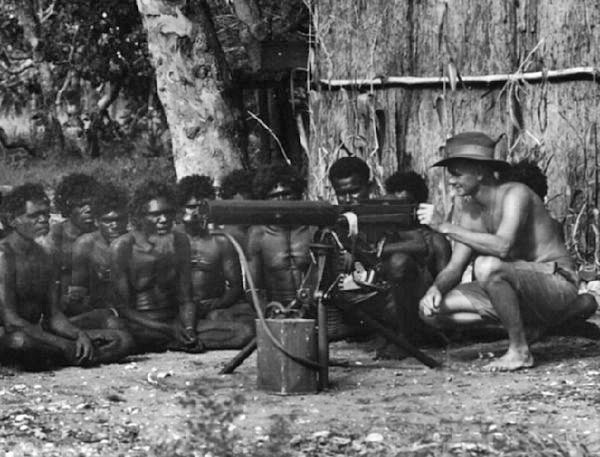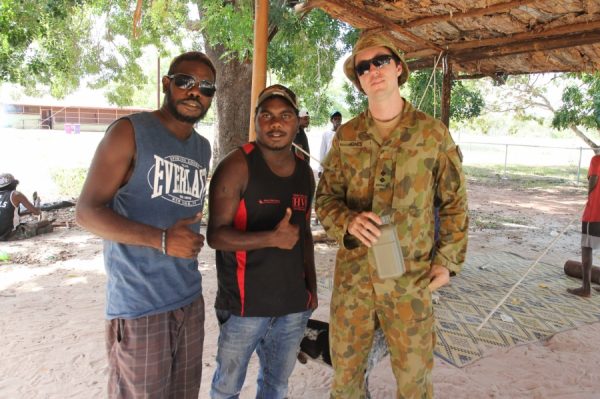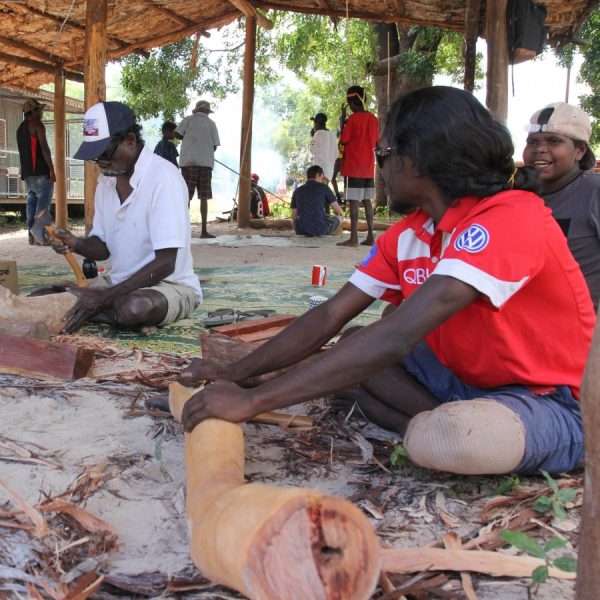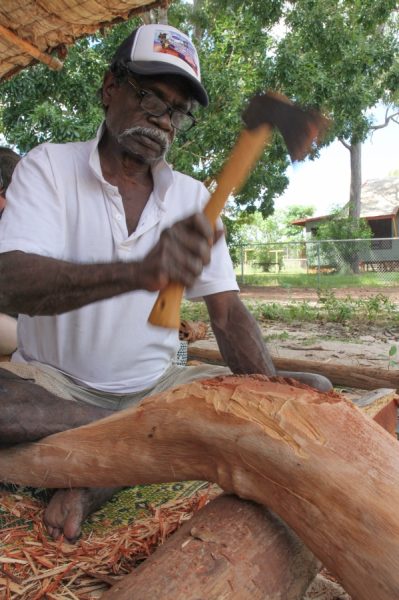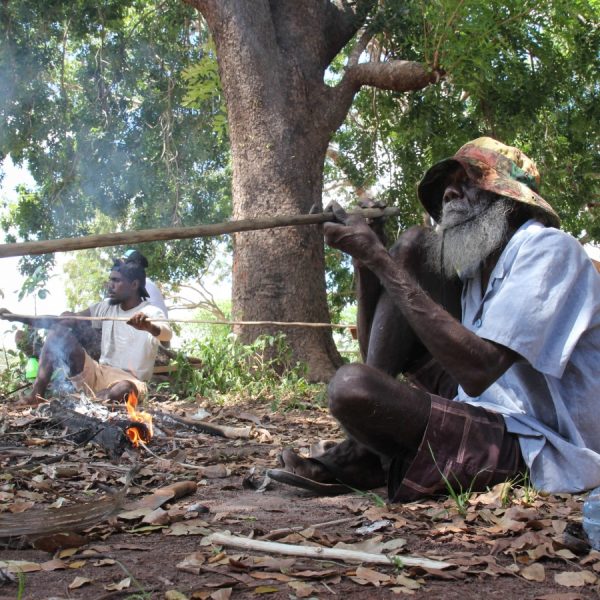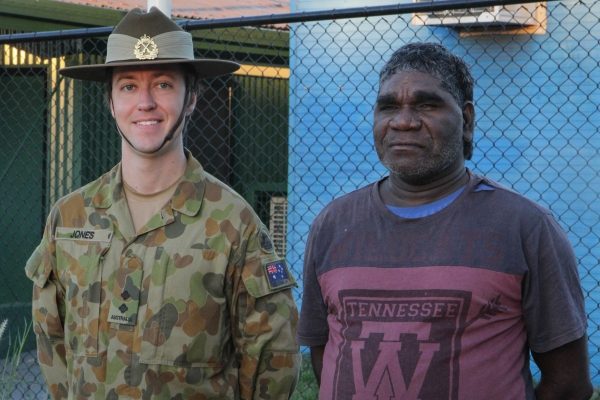We had a unique ANZAC day in Gapuwiyak in 2018. We started with a dawn service where we heard a history about the involvement of Yolngu defending their country (see below). Later that morning we sat at the Art centre and remembered those Yolngu. Some of our leaders and descendants of these Yolngu warriors demonstrated how spears and boomerangs are made. There was plenty of interest from some young men and other community members.
In 1942 and 1943, the country on which we are now standing was a forward combat area in the war between Australia and its Allies and the Empire of Japan. Shipping along the coast to the North was under attack from Japanese aircraft, operating from bases in the Aru and Tanimbar Islands. Darwin itself was frequently attacked and RAAF aircraft based in Darwin were raiding Timor, Ambon and other Japanese Island bases – while the Australian Army and Navy were heavily engaged across the Pacific.
On the 4th of March 1942, an Australian Army Auxillary Ketch – the Aoretta – sailed to an anchorage on the Western side of Hardy Island: between what we now know as the homelands of Raymangirr and Yalakun.
On board the boat were Squadron Leader Donald Thomson, an Officer and Two NCOs from No. 4 Independent Company, 6 Solomon Islanders, 1 Torres Strait Islander and one Yolngu – Donald Thomson’s good friend Raiwalla.
Donald Thomson had been sent to this country, by the Australian Army, seeking help from Yolngu people to defend Arnhem Land. On the advice of Raiwalla, he was looking for two famous mirringu – one of which was based here in Arnhem Bay and led by Bindjarrpuma. By the 7th of March Donald Thomson writes that he had met with Bindjarrpuma and been joined by: ‘36 picked men, all good travellers and hunters, some of them renowned as fighting men in single combat’.
That night, Raiwalla, Bindjarrpuma, Thomson and the 36 warriors set off overland for Caledon Bay and the second famous mirringu – led by the sons of Wonggu. The warriors marched quickly across country, reaching Caledon Bay by the following evening. Once there, Thomson and Raiwalla asked the old man Wonggu to join them in fighting the Japanese. This was a difficult decision, for the sons of Wonggu had recently been imprisoned by the Northern Territory Government for killing Japanese fishermen and Bindjarrpuma’s mirringu had recently been involved in fighting with the Djapu.
Thomson writes that Raiwalla, Bindjarrpuma and himself waited nervously:
‘But that night the ring of iron on iron, the sound of forging of the ‘shovel spears’ were heard in camp, and the rasp of whetstones on spear blades. From this time on, it would have been difficult indeed for even a large enemy landing party to have progressed far in the territory of these warrior people’.
From this meeting was formed the Northern Territory Special Reconnaissance Unit – a group of 51 Yolngu warriors, each armed with four spears, a knife and a tomahawk. They were divided into three Sections, led by Raiwalla, Bindjarrpuma and Natjialma, the eldest son of Wonggu. They patrolled throughout Arnhem Land, inspiring other Yolngu to join the struggle, to work as coast-watchers and messengers or otherwise defend their country.
Many descendants of those original 50 warriors – and others who joined with them – live here in Gapuwiyak today.
The heritage and the legacy of the Northern Territory Special Reconnaissance Unit is proudly maintained by Arnhem Squadron of NORFORCE: through which, soldiers from Gapuwiyak continue a tradition of defending this country.
But this legacy came at a high price.
We gather here on ANZAC to remember fallen Australian soldiers, resting all over the world – from the valleys and ridges of Galliopli and the mud of the Western Front, to the jungles of New Guinea, Borneo, Vietnam, the cold mountains of Korea and Afghanistan to the blazing deserts of North Africa and Iraq.
We also remember with pride those who fell in their own country. We remember the heroic defenders of Milingimbi Air field, many of whom fell staring down Japanese fighter planes with spears – despite being encouraged to take shelter. We remember the coast-watchers, whose dangerous work saved countless Australian airmen but some of whom did not return. We remember those with no grave, such as Djinipula and Djimanbuy Yunupingu , who were killed in the sinking of the Patricia Cam, and Milirrm Marika who was machine gunned in the water – and we remember others such as Babawun Wanambi who returned to their families, but with injuries from which they would never fully recover.
It is for them, as well as others, that we are gathered here today.
References:
D Thomson, ‘Donald Thomson’s Report on the Northern Territory Coastal Patrol and the Special Reconnaissance Unit 1941-43), (ed.) John Mulvaney, Aboriginal History (1992) 16:1, 1-57.
Jeremy Long, ‘The Sinking of the Patricia Cam: Narritjin’s Story’, Aboriginal History (1992) 16:1, 81-4.
Thanks to East Arnhem Regional Shire, Sport and Recreation, Aged Care and Disability, Norforce, Department of Prime Minister and Cabinet.
